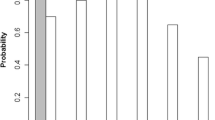Summary
Field observations and laboratory experiments were carried out to determine the influence of body length of preys on the acceptance rate by spiders. Feeding experiments with 13 spider species and a model prey (crickets) reveal a decreasing acceptance rate with increasing prey size. Prey sizes of 50–80% of the spiders' size yielded the highest acceptance rates, crickets of double the spiders' size were accepted by two species only. By fitting the acceptance rate Y versus prey size X by Y(x)=Y(0) (1-βx2), two coefficients could be calculated: Y(0), the size-independent palatibility of the prey and β, a coefficient of size-induced refusal of the prey. These values describe the degree of specialisation towards (a) crickets and (b) large prey, respectively. Further comparison showed (a) that labidognath (= araneomorph) spiders do not necessarily subdue larger prey items than orthognath (=mygalmorph) spiders and (b) that webbuilding spiders are superior to non-webbuilding spiders in respect of catching large prey. A modified model of the generalized pattern of the length relations of predator and prey is given with special reference to spiders and compared to other polyphagous predator groups.
Similar content being viewed by others
References
Bristowe W (1939) The comity of spiders. Ray Society, London vol 2
Buchli H (1969) Hunting behaviour in the Ctenizidae. Am zool 9:175–193
Burgess J (1979) Web signal processing for tolerance and group predation in the social spider Mallos gregalis. Anim Behav 27:157–164
Colquhoun D (1971) Lectures on biostatistics. Clarendon Press, Oxford
Eberhard W (1967) Attack behaviour of diguetid spiders and the origin of prey wrapping in spiders. Psyche 74:173–181
Edwards G (1974) Stoidis aurata (Araneae: Salticidae) a spider predator of ants. Fla Entomol 57:337–346
Enders F (1975) The influence of hunting manner on prey size, particularly in spiders with long attack distances (Araneidae, Linyphiidae, and Salticidae). Am Nat 109:737–763
Foelix R (1979) Biologie der Spinnen. Thieme, Stuttgart
Gettmann W (1976) Beutefang bei Wolfspinnen der Gattung Pirata (Arachnida: Araneae: Lycosidae). Ent Germ 3:93–99
Hespenheide H (1973) Ecological interferences from morphological data. Rev Syst Ecol 4:213–229
Hobby B (1930) Spiders and their insect prey. Proc Entomol Soc London 5:107–110
Holling C (1964) The analysis of complex population processes. Canad Ent 96:335–347
Jackson R (1977) Prey of the jumping spider Phidippus johnsoni (Araneae: Salticidae). J Arachnol 5:145–149
Kaestner A (1969) Lehrbuch der speziellen Zoologie. Fischer, Stuttgart Band I, 1. Teil
Morse D (1979) Prey capture by the crab spider Misumena calycina (Araneae:Thomisidae). Oecologia (Berlin). 39:309–319
Melchers M (1963) Zur Biologie und zum Verhalten von Cupiennius salei (Keyserling), einer amerikanischen Ctenide. Zool Jb Syst 91:1–90
Nentwig W (1980) The selective prey of Linyphiid-like spiders and of their space webs. Oecologia (Berlin) 45:236–243
Nentwig W (1982) Beuteanalysen an cribellaten Spinnen (Araneae: Filistatidae, Dictynidae, Eresidae). Entomol Mitt Zool Mus Hamburg 7:233–244
Netwig W (1985a) Feeding ecology of the tropical spitting spider Scytodes longipes (Araneae, Scytodidae). Oecologia (Berlin) 65:284–288
Netwig W (1985b) Social spiders catch larger prey. A study on Anelosimus eximius (Araneae: Theridiidae). Beh Ecol Sociobiol 17:79–85
Nentwig W (1985c) Prey analysis of four species of tropical orbweaving spiders (Araneae: Araneidae) and a comparison with araneids of the temperate zone. Oecologica (Berlin) 66:580–594
Nentwig W (1986) Web and wrapping behaviour of spiders as important tools in evading the defensive behaviour of insects (submitted.)
Nentwig W (in preparation) Prey specialisation in non-webbuilding spiders
Nyffeler M, Benz G (1981) Einige Beobachtungen zur Nahrungsökologie der Wolfspinne Pardosa Lugubris (Walck.). Dtsch Ent Z 28:297–300
Robinson M, Valerio C (1977) Attacks on large or heavily defended prey by tropical salticid spiders. Psyche 84:1–10
Robinson M, Mirick H, Turner O (1969) The predatory behaviour of some araneid spiders and the origin of immobilization wrapping. Psyche 77:487–501
Turner M (1979) Diet and feeding phenology of the green lynx spider, Peucetia viridans (Araneae: Oxyopidae). J Arachnol 7:149–154
Vollrath F (1984) Kleptobiotic interactions in invertebrates. In: Producers and scroungers Barnard C (ed), Croom Helm, London pp 61–94
Author information
Authors and Affiliations
Rights and permissions
About this article
Cite this article
Nentwig, W., Wissel, C. A comparison of prey lengths among spiders. Oecologia 68, 595–600 (1986). https://doi.org/10.1007/BF00378777
Received:
Issue Date:
DOI: https://doi.org/10.1007/BF00378777




